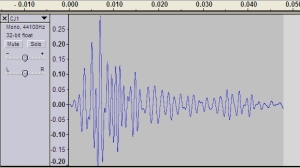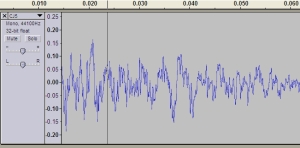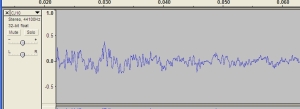It’s been a long time since JG posted comments on the piece I wrote on Dr Colvin’s JSPR paper that started me thinking about running some tests to attempt to falsify the hypothesis offered in that interesting article. I emailed Dr Colvin who very kindly sent me a selection of .wav files so I could look at them. My earlier piece examines Dr Colvin’s paper in detail; however essentially he postulates based on recordings from a number of purported poltergeist cases that the waveform characteristics of sounds made by poltergeists are unusual, with a slow attack and slow decline. Have a look at my earlier post if you don’t follow, and all should become clear. In this post I describe a simple test we did on this idea, and the results…
I had become intensely interested in the issue while debating Campermon over at Rational Skepticism forum. He raised an interesting possibility – if the sound were in fact anomalous, the sustained attack/delayed decline might be due to them not being raps at all, but two surfaces rubbing together – abrasion. As he pointed out, that would produce a waveform similar to that we were looking for, similar to recordings of seismic activity which are after all abrasion on a vast scale. So I downloaded a 30 day trial of Adobe Audition (I don’t have the money to purchase a full copy, so don’t expect much more from me on this!) and started experimenting…
As you can see, this looks a lot like the waveform we are looking for – Campermon’s scratching hypothesis was vindicated. However there was a problem — it sounded wrong, nothing like a “rap”, and nothing like the recordings I had been sent.
So then we started experimenting in earnest. I made a number of control files, simply by banging furniture in my basement: one was Lisa jumping on the floor above, and one was the abrasion of a coffee mug along the desk. Then with 12 wav files total, including the anomalous ones, I submitted them to Campermon, GrahamH and Twistor59. I wish I could use their real rather than forum names but I would have to ask their permission (and what they actually are) so they can reveal themselves if they want).
The Test Files
All of the waveforms for these twelve files can be viewed here on Campermon’s site. I may as well reproduce them here!
Can you spot the four “genuine poltergeist raps” from the files??? We couldn’t. Well I could, because I created the other eight and prepared the blind test, but the others were not so sure.
Interpreting the Results
The problem was that several of the waveforms created by banging furniture by me look like the supposedly anomalous waveforms. Number 6 is just me scraping a coffee mug on the desk – we removed that from most of our analysis, as it sounded so different. Just for the record the “genuine poltergeist” files (in that they were recorded at poltergeist cases) are 1,4, 9 and 12. We decided the only way forward was a less subjective numerical analysis of the data.
A problem now arose, in how one measures what constitutes a slow attack, which Dr Colvin does not mention in his paper. Twistor59 suggested “time from first instance of 10% max amplitude to first instance of max amplitude”. Assuming sample rate = 44.1kHz for all files, we then measured these – well Twistor did. I then noticed something – the attack is always a ratio of the total length of sound, or so it appeared to me. Twistor then recorded the length of each sound, and Campermon tabulated it thus —

I had proposed that the percentage of total duration of sound in the attack was the important factor. Campermon however found a more useful way to graph this —
As Campermon suggests, there are too few data points and our sample size is too small for this to be meaningful, but our very informal tests show no striking confirmation of the hypotheses that the poltergeist raps have unique or indeed particularly unusual characteristics. We would like to see larger tests done, with more poltergeist samples included, but remain very grateful to Dr Colvin for his assistance in supplying the wav files these tests.
So what causes the odd waveform?
Campermon in the debate raises some interesting questions —
“One thing that has nagged me from the Colvin paper was this statement from the abstract;
‘Differences in low-frequency wave properties between the two classes of sounds have been noted.’
OK, this has bugged me because in the body of the paper he doesn’t mention much about this. He doesn’t explain in any detail how he treated the recordings, for example, did he filter out the low frequencies only for his analysis? If so, what band of frequencies? Colvin does not make it at all clear, which is one of my original criticisms of the paper.
One explanation for any anomalous low frequency waves observed on the poltergeist recordings may lie in the fact that they were originally recorded on analogue gear and then digitized. Colvin states that he did digitize some himself, but other, digitized sources, were provided by others. Perhaps these recordings suffered from ‘aliasing’? Aliasing occurs in the digitization of a signal when the input signal frequency is higher than the sampling rate. It results in the addition of low frequency signals appearing on the digitized copy. More here; http://en.wikipedia.org/wiki/Aliasing”
Yesterday I hazarded some thoughts on the subject. What was interesting is that all my original experiments had produced, as you can see from my earlier piece and the debate, the characteristic “normal rap” waveform. However when I recorded my controls, I found some fairly “polt-like” characteristics.
I think two factors are involved, a) the presence of blank wall space that ‘reflects’ the sounds, creating a sustained rise – but I cant be sure that is a factor, I just think it possible b) the transmission of the sounds through two mediums (as demonstrated by the wav file of Lisa bouncing above me through the floor). In most cases my final success in replicating the noises came from hitting an object some distance from the mc stand which rested on my desk – I suspect but do not know that the varying rates of propagation of the sound waves through two different mediums (the air and the desk) led to attenuation of the sound and the waveform characteristic displayed.
This morning just as I was writing this up JG wrote to me describing his experiments on the subject. I am not sure if he intends a more formal publication, but I would very much like to post them on this forum. I have emailed him with details of what we have been up to, and look forward to hearing his thoughts.
Final Thoughts
Assuming I do not have a poltergeist in my basement, or did not use mysterious PK power to alter my recordings 😉 I am afraid that at the moment our attempts to test the hypothesis poltergeist raps are in some way anomalous has proven only that they do not appear in a very small sample to stand out: I suspect the raps are perfectly normal sounds, which is NOT to say they are not caused by a poltergeist. Dr Colvin’s hypothesis they are internally generated in the structure of a substance is supported by the recordings; unfortunately they could just as well be an artefact of large bare walls, recording sounds from the other side of a wall, or many other quite normal factors? Sadly we do not know enough about the conditions in which they were recorded to judge – but further research is clearly required on this fascinating line of inquiry.
Acknowledgements
I’d like to thank firstly and most of all Dr. Barrie Colvin who has offered a quantifiable and fascinating hypothesis, and supplied the four sound files we used; my colleagues in “beer mat parapsychology” and “beer mat physics” Campermon, GrahamH, Twistor59, and everyone who has commented from RationalSkepticism.org, JG for his invaluable comments on this blog, and Becky Smith and Lisa Langood for their tolerance of my loud thumping in the basement and helpful suggestions, and finally Anthony McCann for his hilarious poltergeist rap he composed and recorded to amuse Wendy Cousins and myself!
cj x















Regarding low frequencies, the paper says that the poltergeist raps tended to be restricted to lower frequencies below 1 kHz. When a sound source is remote from the listener, the higher frequency portions are not usually present. This is because air absorbs these higher frequencies preferentially.
Since it is unlikely that the tape recorders were very close to the sound sources, this is to be expected.
The paper doesn’t say how the recordings were digitised in detail. However, it is likely that a sampling frequency of 44k was used which, for signals down in area of a few kHz, would represent significant over-sampling. This would have reduced any possible aliasing which I doubt is a significant factor here.
Slow attack occurs if there are sound reflections from surrounding walls in a room. This means that some of the sound arrives later than the portion coming by the most direct route. This typically produces a delayed attack measured in hundredths of a second for typical domestic size rooms. It also explains why sounds go on for longer.
One thing about the audio readings is that are generally very limited in the information that that can give us, being more or less a very thin timeslice of a very narrow perspective on the sounds. I know how frustrated I get when people comment on the meaning of a traditional Irish session by simply using synchronic musical notation. I wonder what other tools we might have to analyse the sounds? It’s an open question, as I can’t think of anything this early in the morning. Also, the whole poltergeist/soundfile discussion a bit like ethnomusicologists trying to link sound to social structure (see Steven Feld, Alan Lomax etc.) – a wonderful discussion, but rarely dealt with in a way that I find satisfactory. Thanks for the nod! 🙂
Just one question, why should the alleged poltergeist rappings be so different, are they not all subject to the same forces as every other sound made in the universe ?
Dr Colvin’s hypothesis is that the origin of the sounds originates within the substance itself, not as a surface knock. This would seem a highly sensible hypothesis, that may well be supported by the slow attack/decline found in the sound samples collected to date. What has become apparent however is that various other circumstances can give rise to the purportedly characteristic waveform: hence this post and the follow up by JG. Jase, I’d love to analyse some of your rapping sound smples? Dr Colvin is a relly good bloke and i believe lives in your part of the world, maybe you can catch up with him at an SPR event? cj x
Pingback: Ep.83 – Prof. John Poynton | Righteous Indignation – Skeptical About the Supernatural
Pingback: Poltergeist Acoustics – Brighton Paranormal